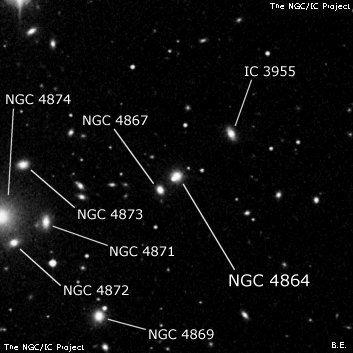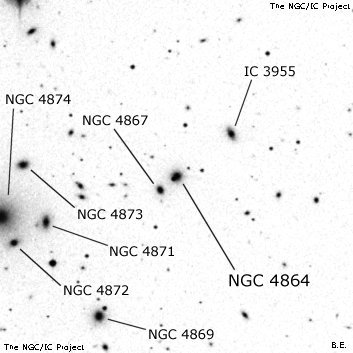NGC/IC Project Restoration Effort
(This is a very very beta version)
NGC4864


Basic Information
Location and Magnitude
Right Ascension: 12:59:13.2
Declination: +27:58:35
Constellation: COM
Visual Magnitude: 13.6
Historic Information
Discoverer: Herschel J.
Year of discovery: 1831
Discovery aperture: 18.3
Observational
Summary description: F, S, p of 2
Sub-type: E6
Corwin's Notes
=====
NGC 4864. WH found three nebulae -- II 388, 389, and 391 -- in the core of
the Coma Cluster on the night of 11 April 1785, but only had time to take two
positions. The first of these applies to "Two. The time taken between them."
He has them 7m 46s preceding, 22 arcmin north of 46 Comae. This position
falls northwest of NGC 4874 in a blank spot in the cluster, just as WH's
description suggests.
One of the pair is almost certainly NGC 4874 itself. At V_T = 11.7 it, along
with NGC 4889 at V_T = 11.5 (which is WH's third nebula, by the way), is two
magnitudes brighter than any other galaxy in Coma's core (there are other
galaxies nearly as bright in the outskirts, of course). So, we can be
virtually certain that it was the eastern of WH's pair.
But which is the western? There are several candidates, the brightest of
which are NGC 4864 (V_T = 13.6) and NGC 4869 (V_T = 13.8). But N4869 is five
arcminutes south of WH's position. So it seems reasonable to suppose that
N4864 is WH's second galaxy.
This has some other things going for it, too. There is a star superposed on
the southeast side, and NGC 4867 is less than an arcminute on further to the
southeast. This may have enhanced the view of N4864 itself, or perhaps WH saw
all three of the objects blended into a single image.
Among the other candidates are the three galaxies around the western side of
NGC 4874: NGC 4871,72,73. But at V_T = 14.1, 14.5, and 14.4, these are all
fainter than NGC 4864. Even in the relatively high-contrast POSS1/DSS field,
they are not as eyecatching as the brighter galaxy.
So, I'm going to suggest NGC 4864 (perhaps with NGC 4867) as the western of
WH's pair.
Dreyer certainly has two WH numbers assigned incorrectly to NGC 4869 and 4872;
they should go on NGC 4864 and 4874, respectively.
And here is another story, this one about JH. He swept over the Coma core
three times. We might expect him to pick up several galaxies here, and he
indeed has: "... 5 south of a * 7m." These five appeared during his last
sweep on 13 April 1831. He was apparently rushed as none of the positions are
secure. However, those in the first two sweeps (26 and 30 March 1827) are
good enough to clearly identify NGC 4874, 4889, and 4898 as the first three
galaxies he saw.
The situation is not quite as clear for the five seen in 1831. While it is
likely that his five objects are NGC 4864, 4869, 4874, 4889, and 4898 -- these
are the brightest five in the core -- JH's positions are only a modest match
for the modern positions, leaving the identifications for them uncertain, at
least from the positions alone.
Four of those positions are noted "by configuration" (three) in his 1833
catalogue and "by diag[ram]" (all four) in the sweep. Nor are they given to
the same precision (only a minute of time and one arcminute in the sweep,
though to a second of time in the published catalogue). JH's diagram looks
something like this, with south at the top and east to the left:
# b
# c
e #
# d # a
$ * 7m
where the pound signs (#) represent his nebulae, the dollar sign his 7th
magnitude star (which is HD 112887 with V = 7.2), and the letters are his
labels in the sweep of the five galaxies (I have put the labels in the same
positions relative to the nebula symbols as JH has them in his diagram). His
pencil smudges representing nebulae "c" and "d" are larger than the other
three, so it is pretty clear that these represent the brighter NGC 4874 and
NGC 4889. Given those two identifications, "e" is clearly NGC 4898, with "a"
perhaps NGC 4864 and "b" probably NGC 4869. However, with the sketched
positions of "a" and "b" somewhat distorted from the sky, the identifications
are still a bit uncertain. JH identifies "d" as H III 391 in his sweep, and
this is indeed NGC 4889.
And so things stood when JH put together the GC. Here are the five entries
from the GC for the two Herschel's observations as sorted out by JH:
GC h H RA (2000) Dec GC Description JH diag.
3343 1500 --- 12 59 27 +27 57.9 1st of 5; *7 n a
3344 1501 II 388 12 59 35 +27 56.7 eF, S, R; *7 n; 2nd of 5 b
3347 1502 II 389 12 59 46 +27 57.9 3rd of 5 c
3351 1507 II 391 13 00 10 +27 59.3 pB, pmE, bM; *7 n; 4th of 5 d
3354 1510 III 363 13 00 15 +27 57.4 pF, S, R; *7 n; 5th of 5 e
Things were pretty simple then. These five correspond, following my comments
above, to NGC 4864, NGC 4869, NGC 4874, NGC 4889, and NGC 4898. Note, though,
that III 363 is almost certainly NGC 4908 (which see), and not NGC 4898. The
modern positions are not at great odds with these identifications, so I think
that we have the Herschels' observations in Coma clear.
Since most of the positions for the NGC galaxies in Coma come from d'Arrest
and Bigourdan, we need to look at those, too. I'll discuss them as they come
up, but particularly see NGC 4872, 4874, 4882, and 4884 for special
consideration of d'A's observations; and NGC 4871, 4872, 4875, 4896, and 4898
for similar, though perhaps less detailed, discussions of Bigourdan's
observations.
Steve's Notes
=====
NGC 4864
18" (4/20/12): fairly faint to moderately bright, small, round, 24" diameter, well concentrated with a bright core that increases to a stellar nucleus. On the DSS there is a faint star superimposed, so perhaps this is the stellar nucleus I noted. Forms a very close double with NGC 4867 just 36" SE.
17.5" (4/21/90): faint, very small, round. Forms a double system with NGC 4867 off the SE edge just 40" from center and IC 3955 is 2' NW. Located in the core of AGC 1656, 5.0' WNW of NGC 4874.
13" (5/14/83): faint, very small, round, very close pair with NGC 4867.



